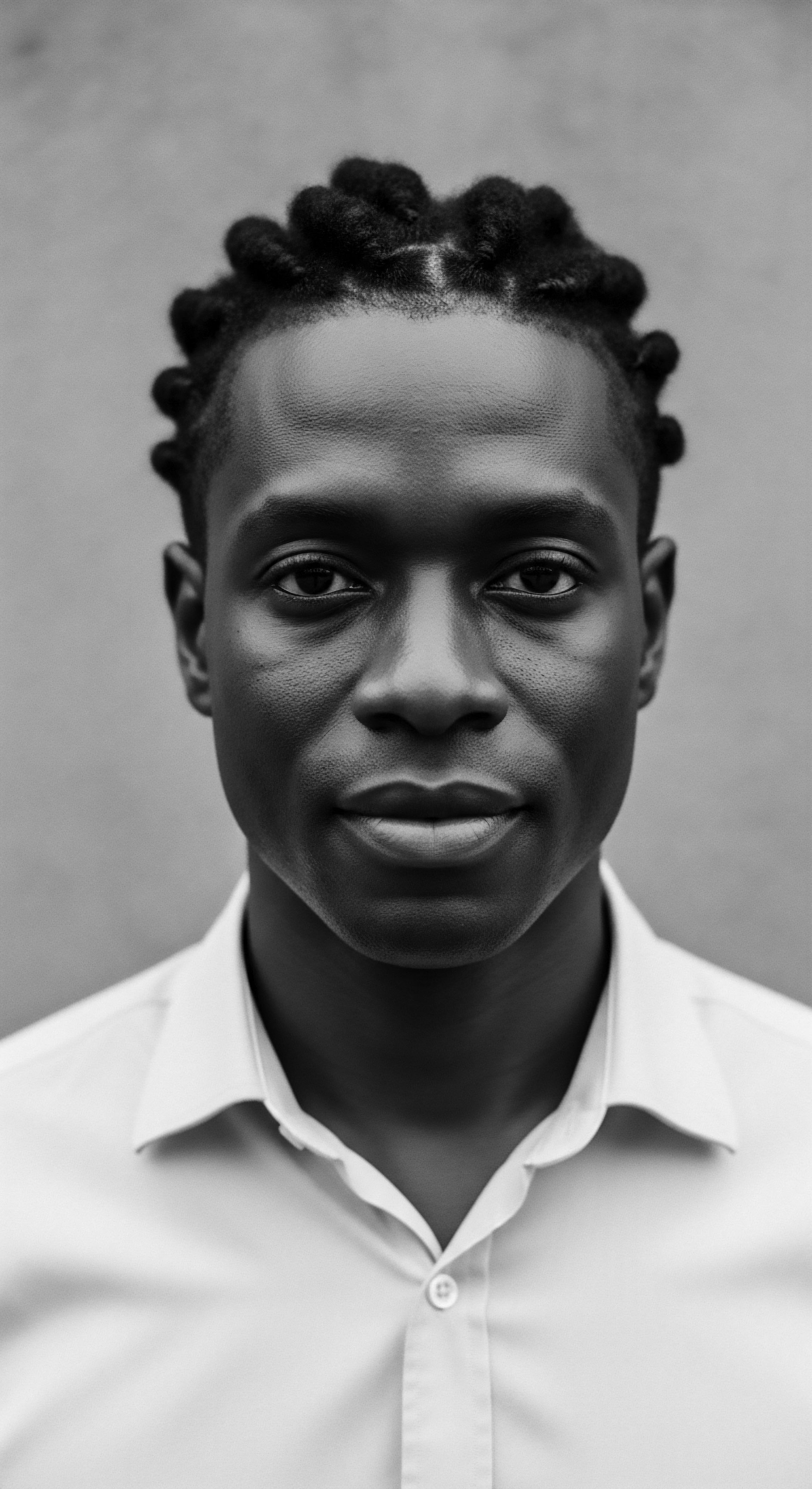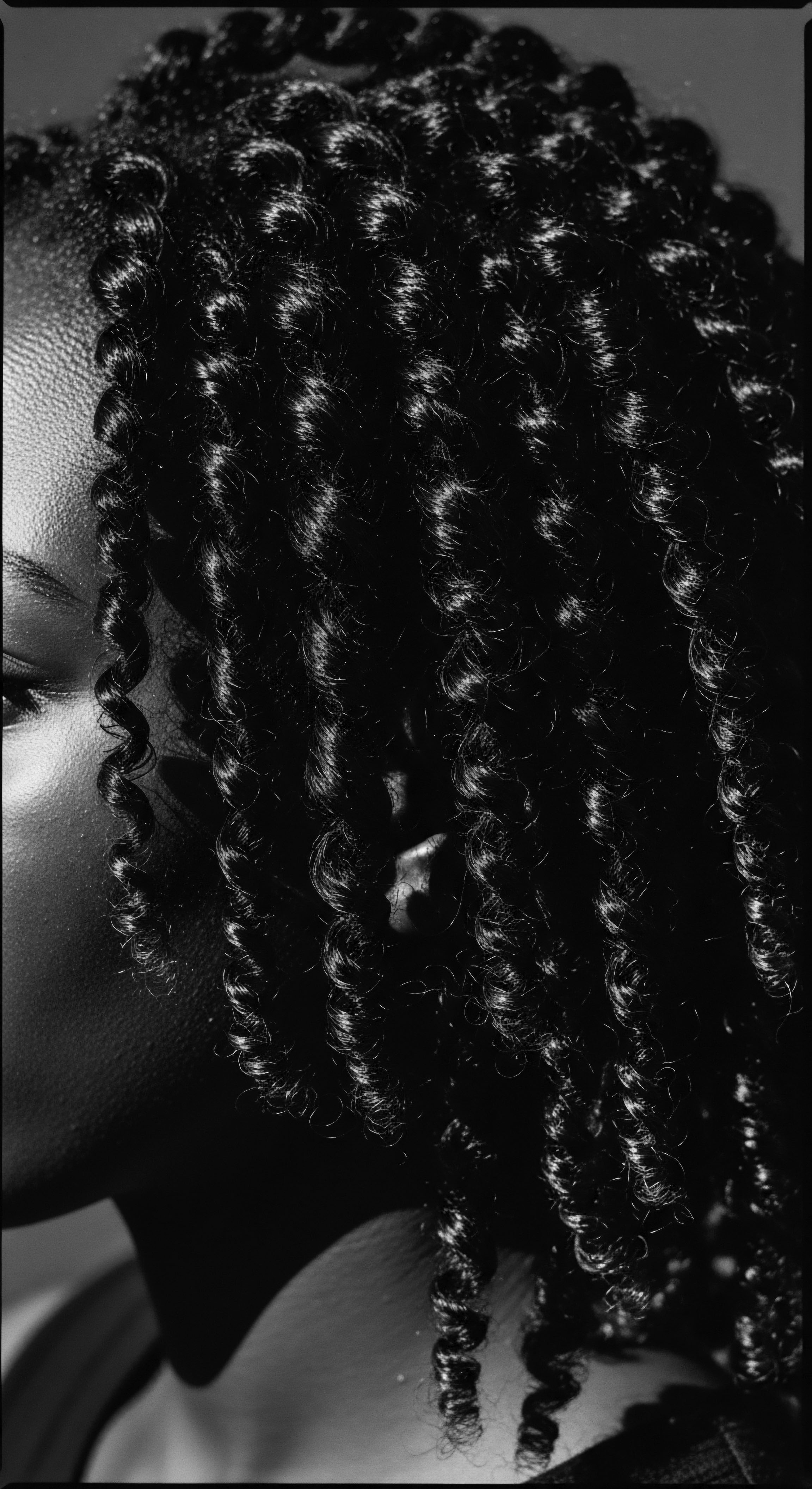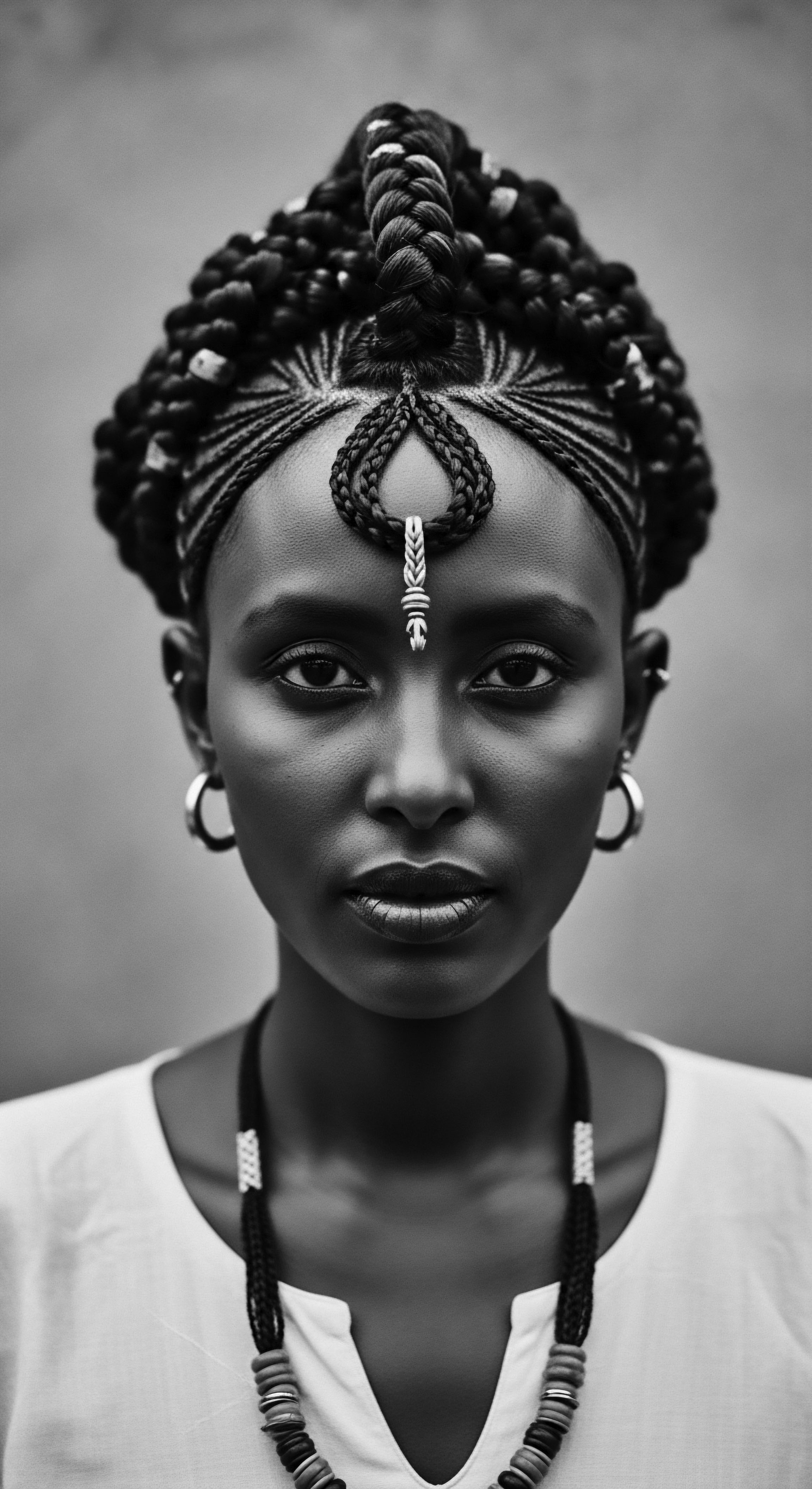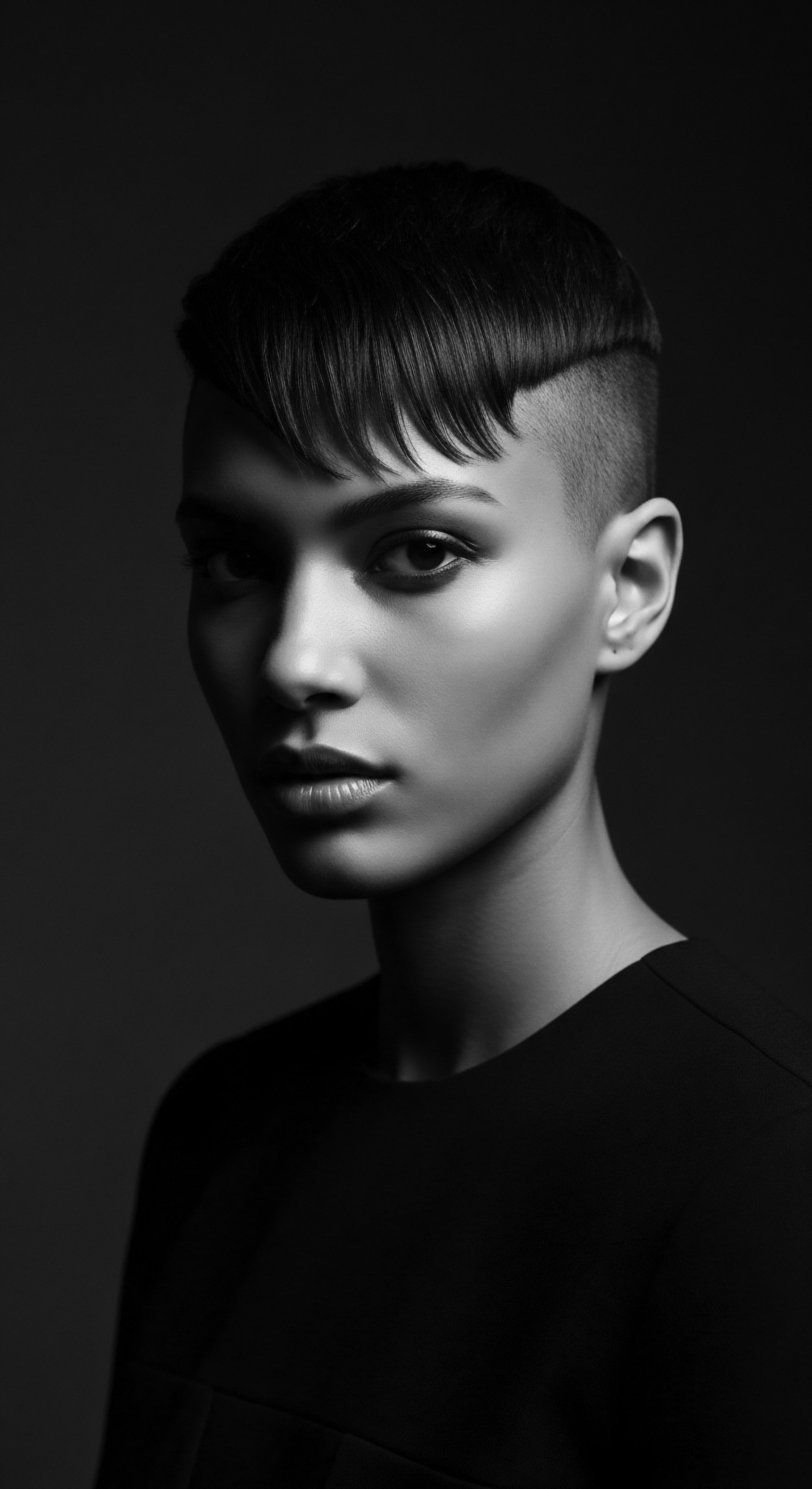
Roots
To hold a strand of textured hair is to hold a story, a living scroll etched with generations of wisdom, resilience, and beauty. For those of us with coils and kinks that defy simple definitions, our hair is not merely a biological structure. It stands as a profound connection to ancestry, a testament to practices honed through centuries, far from fleeting trends or market whims. The question of how ancestral shea butter extraction benefits textured hair invites us into a deep meditation on this very lineage.
It pulls us into a rich past, a past where care was communal, ingredients were sacred, and knowledge flowed like river currents from elder to child. This is not about a product; it marks a continuum, a living echo of traditions that understood hair’s innate needs with an acuity modern science now strives to understand.
Before we analyze the very structure of textured hair and the historical methods that nourished it, let us reflect on the profound bond between the shea tree and the communities that have depended upon its golden bounty. The shea tree, Vitellaria paradoxa, grows wild across the Sahelian belt of Africa, a vast region spanning from Senegal to Uganda. This tree, revered in many cultures, offers its fruit, yielding the precious butter.
Its sustained presence within West African life has shaped entire communities, with the painstaking work of extraction often resting upon the hands of women, weaving a collective legacy of self-sufficiency and communal bonds. It is this specific, hands-on, traditionally informed extraction that gives ancestral shea butter its distinctive character, setting it apart from its industrially processed counterparts.

Hair Anatomy and Textured Hair
The very architecture of textured hair, with its unique bends, twists, and coils, naturally presents a greater challenge to moisture distribution. The natural oils produced by the scalp, called sebum, struggle to travel down the hair shaft’s winding path. This structural reality makes textured hair inherently more prone to dryness and breakage. Understanding this foundational aspect of hair biology sets the stage for appreciating the ancestral wisdom that sought out ingredients capable of mitigating these vulnerabilities.
Ancient communities, without electron microscopes or chemical assays, possessed an innate, experiential understanding of these characteristics. Their observations, passed through oral histories and daily rituals, recognized the particular needs of kinky, coily, and wavy strands. They saw the dry ends, the way moisture would evaporate quickly in arid climates. Their solutions, therefore, aimed at deeply moisturizing and sealing the hair, providing a protective barrier against environmental aggressors.

Traditional Classifications of Hair and Care
Across various African cultures, hair classification extended beyond mere appearance; it carried social, spiritual, and communal meanings. While modern systems categorize hair by curl pattern (e.g. 3A, 4C), ancestral societies often classified hair based on its readiness for styling, its health, or its role in identity markers. A woman’s hair might signify her marital status, her age, or her tribal affiliation.
Hair care, therefore, was never a solitary act. It was a communal ritual, a time for intergenerational exchange, and a practice interwoven with cultural identity. In Ghana, for instance, shea butter, known as Nkuto, holds significance beyond its practical uses. It is a symbol of tradition and cultural pride, utilized in rituals such as naming ceremonies, weddings, and funerals. Babies are massaged with it for good health and skin protection.
The journey of ancestral shea butter begins not in a laboratory, but in the heart of West African communities, where it signifies a deep connection to shared heritage.
The methods of hair care were inextricably linked to these cultural classifications. Hair that needed extra softening for intricate braids received more butter. Hair prepared for a journey in harsh sun received a thicker coating for protection. These were not arbitrary choices, but rather responses honed over centuries, reflecting a profound understanding of hair’s nature and its place within human experience.
| Ancestral Focus Moisturizing Hair for Pliable Braiding |
| Underlying Textured Hair Need Hair's tendency toward dryness and breakage due to coil structure. |
| Ancestral Focus Protection from Sun and Wind |
| Underlying Textured Hair Need Hair's vulnerability to environmental stressors, especially in dry climates. |
| Ancestral Focus Scalp Health and Growth Stimulation |
| Underlying Textured Hair Need Promoting a healthy foundation for hair growth and mitigating common scalp conditions. |
| Ancestral Focus Ancestral wisdom intuitively addressed the inherent characteristics of textured hair long before modern scientific inquiry. |

Ritual
The methods of ancestral shea butter extraction represent a powerful expression of communal artistry, a series of labor-intensive steps passed down through oral tradition, from one generation of women to the next. This process is far removed from the cold machinery of industrial production; it is a ritual infused with song, storytelling, and collective participation, giving the resulting butter a vibrational quality that speaks to its origins. The way shea butter influenced and became part of traditional styling heritage is a testament to its intrinsic value within Black and mixed-race hair practices.

The Craft of Extraction and Its Properties
The traditional process of producing shea butter is a painstaking journey. It begins with the collection of fallen shea fruits, often gathered communally by women, followed by de-pulping to access the nuts. These nuts are then cleaned, dried, and often boiled to prevent germination and ensure the integrity of the oil. Next, the kernels are sun-dried or roasted, which lends a characteristic aroma and color to the butter.
The roasting step also contributes to the butter’s stability by deactivating certain enzymes. After roasting, the kernels are ground into a paste, often using traditional stone mills or mortars and pestles. The paste is then kneaded, sometimes with the addition of water, to separate the fat. This kneading is a crucial step, requiring considerable physical effort and skill. Finally, the separated butter is skimmed, purified through boiling, and left to cool and solidify.
This traditional method, while arduous, preserves the natural integrity of the shea butter, retaining its full spectrum of beneficial compounds. Unrefined, traditionally extracted shea butter is rich in vitamins A, E, and F, along with essential fatty acids and natural antioxidants. These components offer remarkable moisturizing, anti-inflammatory, and healing properties. The absence of harsh chemicals or high-heat processing, common in modern industrial extraction, means that the butter retains its authentic composition, which ancestral communities knew to trust implicitly.

How Does Ancestral Extraction Influence Shea Butter’s Beneficial Components?
The gentle, traditional processing methods, which avoid high heat or chemical solvents, allow shea butter to retain its full array of naturally occurring compounds. These include:
- Fatty Acids ❉ Oleic acid, stearic acid, linoleic acid, and palmitic acid are present in significant proportions. Oleic and stearic acids are particularly important for moisturizing and maintaining the hair’s lipid barrier.
- Vitamins A and E ❉ These fat-soluble vitamins are natural antioxidants, offering protection against environmental stressors and supporting cellular health. Vitamin E contributes to hair growth and shine.
- Triterpenes and Cinnamates ❉ These compounds provide anti-inflammatory benefits and some natural UV protection, historically valuable for hair and scalp exposed to intense sunlight.
These components work in concert, offering a synergistic benefit that may be diminished in highly refined, industrially produced shea butter. The traditional process honors this natural synergy.

Shea Butter’s Role in Traditional Hair Styling
For centuries, shea butter served as a cornerstone of hair care and styling within West African societies and across the diaspora. Its rich, emollient texture made it ideal for conditioning and sealing moisture into textured strands, preparing them for intricate styles and protecting them from the elements.
Soninke men, for example, historically wore braided or locked hairstyles, which they coated with shea butter. Soninke women also crafted complex braided styles, using shea butter to aid the process and maintain the hair’s integrity. This practice highlights how shea butter was not merely a cosmetic but a functional tool that enabled specific cultural expressions through hair.
Traditional shea butter extraction is a labor of love, a women-led endeavor that safeguards the butter’s natural potency.
Beyond simple conditioning, shea butter was crucial for:
- Detangling ❉ Its slippery texture helped to loosen knots and facilitate the combing process for tightly coiled hair, reducing breakage.
- Sectioning and Braiding Aid ❉ Applying shea butter to sections of hair made them more manageable and easier to braid, twist, or coil, ensuring smoother, neater results and reducing tension.
- Sealing Moisture ❉ After moisturizing hair with water or herbal infusions, shea butter would be applied to seal in the hydration, a critical step for textured hair which loses moisture quickly.
- Scalp Treatment ❉ Massaging shea butter into the scalp helped to soothe dryness, reduce flaking, and promote a healthy environment for hair growth.
- Protective Barrier ❉ In harsh climates, the butter provided a physical barrier against sun, wind, and dust, protecting both hair and scalp.
| Aspect Process |
| Traditional Extraction (Ancestral) Labor-intensive, multi-step, communal, often by hand (harvesting, drying, crushing, roasting, grinding, kneading, boiling). |
| Modern Extraction (Industrial) Mechanical presses (hydraulic/screw), solvent extraction (e.g. hexane), high-heat processes. |
| Aspect Product Quality |
| Traditional Extraction (Ancestral) Unrefined, retains full nutrient profile, distinctive aroma, culturally significant. |
| Modern Extraction (Industrial) Refined, may lose some natural properties due to heat/chemicals, neutral aroma, higher yield. |
| Aspect Economic Impact |
| Traditional Extraction (Ancestral) Empowers rural women, often via cooperatives, direct income at community level. |
| Modern Extraction (Industrial) Scalability, efficiency for global markets, often benefits larger corporations. |
| Aspect Traditional methods prioritize purity and community while modern methods focus on industrial scale and efficiency. |

Relay
The journey of ancestral shea butter, from wild harvest to its transformative role in hair care, represents a relay of wisdom passed through generations. Its efficacy for textured hair, rooted deeply in cultural practices, finds validation and deeper explanation through contemporary scientific understanding. This convergence of ancestral knowledge and modern research allows for a more profound appreciation of why these traditions endured. The analysis of how ancestral shea butter extraction benefits textured hair must therefore consider this interplay, moving beyond surface-level observations to embrace a complex, multi-dimensional, and heritage-focused viewpoint.

How Does The Molecular Composition of Ancestral Shea Butter Support Hair Integrity?
The true marvel of shea butter, particularly that produced through ancestral methods, resides in its unique molecular composition. Unlike many plant oils dominated by a single fatty acid, shea butter boasts a balanced profile of both saturated and unsaturated fatty acids, alongside a significant unsaponifiable fraction. This latter portion, rich in triterpenes, tocopherols (Vitamin E), phenols, and sterols, is what sets shea butter apart and contributes significantly to its therapeutic properties. The traditional water-extraction method, which often involves boiling the kernels and skimming the butter, tends to preserve these unsaponifiables more effectively than solvent-based or high-heat mechanical extractions.
For textured hair, prone to dryness and external damage, this composition is particularly beneficial:
- Moisture Retention ❉ The fatty acids, particularly stearic and oleic acids, create a protective, occlusive barrier on the hair shaft. This barrier minimizes trans-epidermal water loss from the scalp and prevents moisture from escaping the hair strand, keeping it hydrated for longer. This is especially crucial for coily textures where sebum struggles to coat the entire strand.
- Emollient Properties ❉ The butter’s soft, creamy texture allows for easy application and absorption, smoothing the hair cuticle. This reduces friction between strands, which translates to fewer tangles and less breakage during manipulation. The resulting supple hair is less brittle and more resilient.
- Anti-Inflammatory Action ❉ The unsaponifiable compounds, such as lupeol cinnamate, offer soothing benefits to the scalp. Many individuals with textured hair also experience scalp dryness, irritation, or conditions like seborrheic dermatitis. Ancestral applications, which often involved massaging shea butter into the scalp, addressed these concerns, promoting a healthier environment for hair growth. Research confirms shea butter’s anti-inflammatory properties, making it a valuable agent for scalp health (Diop, 1996).
- Antioxidant Protection ❉ The presence of vitamins A and E acts as a shield against oxidative stress from environmental pollutants and UV radiation. Textured hair can be particularly vulnerable to environmental damage, which weakens the protein structure. Antioxidants help to neutralize free radicals, thereby preserving the hair’s protein integrity and color.
- Natural UV Filter ❉ Certain cinnamic acid esters in shea butter offer a mild natural sunscreen, providing protection against the sun’s harmful rays. This was an unquantified but certainly observed benefit in regions with intense sun exposure, helping to preserve the strength and vibrancy of hair strands.

Understanding Traditional Practices Through Modern Research
The collective wisdom of women across the shea belt, honed over centuries, intuited these benefits without formal scientific terms. Their practices – from the careful collection of nuts to the laborious kneading – were, in essence, an empirical science. A study in Northern Ghana revealed that shea butter (Vitellaria paradoxa) was the most used plant by females for smoothening the skin and enhancing hair growth, highlighting its perceived efficacy within traditional cosmetic ethnobotany. This quantitative insight underscores the lived experience of countless individuals who relied on shea butter for their hair care.
Ancestral extraction methods preserve shea butter’s potent, natural compounds, validating traditional uses through a scientific lens.
The concept of “sealing” moisture, a cornerstone of textured hair care today, was inherent in ancient applications. After washing hair, perhaps with traditional black soap, shea butter would have been applied to lock in the water, a practice that mirrors modern “LOC” or “LCO” methods (Liquid, Oil, Cream). This historical continuity speaks to a timeless understanding of textured hair’s need for sustained hydration.

The Communal & Economic Relay of Ancestral Shea
The story of ancestral shea butter is also an economic and social one, predominantly written by women. In West Africa, shea butter is often referred to as “women’s gold” because it represents a significant source of income, particularly in rural areas. Organizations and cooperatives, such as the Sunkpa Shea Women’s Cooperative in Ghana, empower over 800 indigenous women by enabling them to produce organic shea butter for international supply chains, directly improving livelihoods and community well-being.
This collective effort and generational transfer of knowledge are integral to the very definition of ancestral shea butter. It means not just the biochemical composition, but the hands that touched it, the songs sung over it, and the shared purpose that brought it to being. The social structure around its production reinforces its authenticity and its connection to a living heritage.
The influence of shea butter also extends beyond individual hair care routines. During the transatlantic slave trade, as enslaved Africans faced attempts to erase their identity, they carried knowledge of natural remedies, including shea butter, from their homelands. These practices became acts of self-preservation and resistance, allowing for the continuation of cultural hair traditions despite oppressive circumstances. The continued use of shea butter in the diaspora, therefore, is not simply about beauty; it is about reclaiming and sustaining a connection to a deep, often painful, but ultimately resilient heritage.
| Aspect Traditional Craftsmanship |
| Cultural Significance Knowledge transmission, communal bonding, ritual use in life events. |
| Economic Empowerment Supports local economies, provides seasonal income, reduces reliance on external markets. |
| Aspect Women's Role |
| Cultural Significance Custodians of ancient knowledge, symbols of strength and autonomy. |
| Economic Empowerment Primary producers, beneficiaries of income, increased financial independence. |
| Aspect Product Value |
| Cultural Significance Symbol of tradition, purity, and connection to land. |
| Economic Empowerment Unrefined butter commands premium prices due to purity, ethical sourcing. |
| Aspect The production of ancestral shea butter intertwines cultural legacy with tangible economic benefits for women and communities. |

Reflection
To consider the efficacy of ancestral shea butter extraction for textured hair is to undertake a profound meditation, one that traces the invisible lines of heritage back to their very source. It is to recognize that the care for our coils and curls is not a modern invention, but a practice steeped in ancient wisdom, a wisdom that understood the interplay of nature, community, and personal identity. The ‘Soul of a Strand’ ethos finds its living archive in this golden butter, a tangible link to foremothers who, with knowing hands, kneaded strength and vitality into generations of hair.
This understanding beckons us to look beyond the surface of a mere ingredient and see it as a symbol of continuity, of resilience, and of a profound connection to the earth and its gifts. The benefits of ancestral shea butter are not simply measured in molecular composition or botanical properties; they reside equally in the enduring legacy of the women who have sustained its production, transforming a wild fruit into a balm of sustenance and beauty. Their labor, their knowledge, and their communal spirit are woven into every application, offering more than just moisture or protection.
They offer a living testament to heritage, inviting us to partake in a tradition that honors the inherent beauty of textured hair and the deep roots from which it springs. This journey back to the source allows us to truly cherish the resilience of our hair and the wisdom that guides its care, connecting us to a lineage of care that remains as vibrant and relevant today as it was centuries ago.

References
- Lovett, P. N. (2004). The biology and utilization of shea butter tree (Vitellaria paradoxa Gaertn. f.) in West Africa. Ph.D. Thesis, University of Wales, Bangor.
- Diop, T. (1996). Les Plantes Médicinales, Sénégal.
- Adana Maimouna. (2025, March 7). Codex Helps Women to Better (Shea) Butter Returns in West Africa. Codex Alimentarius.
- Global Shea Alliance. (n.d.). The Global Shea Alliance.
- Sharaibi, O. J. et al. (2024). Cosmetic Ethnobotany Used by Tribal Women in Epe Communities of Lagos State, Nigeria. Journal of Complementary Medicine & Alternative Healthcare, 12(4), 555845.
- Höhn, A. & Lovett, P. (2024). Shea Parklands Face Various Threats – Can Archaeobotany Help Preserve Them? ResearchGate.
